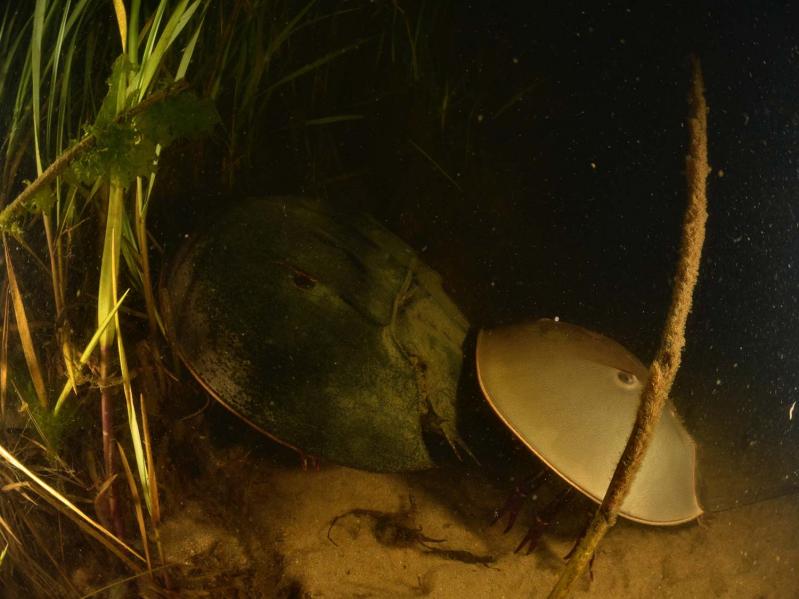An all-night orgy at a beach in Amagansett last Thursday drew only a muted response from the East Hampton Town Marine Patrol, which issued a single ticket, to a man who didn’t have a valid permit to drive on the beach. The event drew over 1,000 participants, and was documented by two East Hampton Town Trustees, Jim Grimes and Ben Dollinger, and the volunteers Margarette Doyle, Dermot Quinn, and even their 11-year-old daughter, Saoirse.
Indeed, it’s mating season for the horseshoe crab.
During the last few new and full moons, they’ve coupled in great numbers along our bay beaches, as they’ve done for 400 million to 500 million years. For Mr. Grimes, the evening began photographing diamondback terrapins, asleep on the bottom of a harbor. Despite recent rains, which made the water murky, he managed to find three. “Well, at least they’re here,” he said. When high tide hit at 10:24 p.m., the winds were light, the water temperature was 63 degrees, and Mr. Grimes, wearing a full wetsuit, transitioned to the crabs.
Whippoorwills had sung the moon far enough off the horizon to light up a contrail. Directly overhead, where the sky was darker, the Big Dipper poured stars into the clear sky. The familiar frog of the East End, the spring peeper, was chirping as usual, joined by the deep unfamiliar buzz of the Fowler’s toad. A train passed, heading to Montauk. From Route 27, the sound of tires, moving east and west.
“At least this is a nice night,” said Mr. Grimes. “We did a count in April. It was cold and wet.”
“Sometimes there’s weird people out here, walking around in the dark,” said Mr. Dollinger, “but it’s just beautiful out here. We did one from midnight to 2 a.m. the other night. I was hurting the next day, but it’s something different.” There were no weird people last week, other than the five souls walking through thigh-high water with flashlights pointed down, searching for horseshoe crabs.

The group was monitoring the crabs for the Cornell Cooperative Extension using tags issued by the New York State Department of Environmental Conservation.
“Five males, one female. Submerged,” said Mr. Grimes, walking ahead of the pack. Behind him, Ms. Doyle held a clipboard, writing down the numbers dictated by the two trustees. Mr. Dollinger came upon a larger group. “Fifteen males, three fe- males.” Two weeks prior, they had their most successful count ever, find- ing 1,165 crabs.
The group walked 800 meters from the point back to where they had parked their cars, heads down, staring into the water glowing green from their flashlights, calling out numbers, shooshing, surrounded by darkness, whippoorwills, amphibians, and of course the crabs. It was dreamy and impossibly different from the more common story told of the Hamptons, especially in the lead-up to Memorial Day weekend.
Ms. Doyle compiled the numbers and reported 1,063 crabs. “Tonight, it was really strong again,” said Mr. Grimes. “We had a little more than 600 the night before last.”
“This year’s counts have been way higher than previous years and not by a little but by a lot,” Mr. Grimes said by text yesterday. “The night you joined us we had over a thousand. Same time last year our highest number was around 700. . . .”
Horseshoe crab populations are under pressure in part because the medical industry collects crabs and harvests their copper-based blood for use in the Limulus Amebocyte Lysate test, which detects bacterial contamination in vaccines and on medical devices. The practice is unrestricted. “There is no reason for America to be still using their blood since there is a synthetic version that works just as well,” Ms. Doyle wrote in a text.
The arthropods are also collected by commercial fishermen and ground up into bait. The New York State Department of Environmental Conservation limits the total annual harvest to 150,000 crabs and closes the harvest during the spring new and full moon cycles. A bigger issue is poaching.
“I’ve been checking everywhere tonight,” said Brian Labelle, a member of the East Hampton Town Marine Patrol who showed up to ask the group what they were doing. “It has been a big problem. We think they’re selling it in restaurants in Queens and the Bronx. I had one guy admit that. These are not harvestable unless you have a very hard-to-get license.”
Eggs of the horseshoe crab are a key dietary need for many shorebirds, themselves suffering steep population declines since the 1970s. For example, the red knot is a shorebird that times its migration to the egg-laying schedule of the horseshoe crab. The two species are tied together. If horseshoe crabs dwindle, so will the knots.
After the count was complete, it was time to tag the crabs. This involved capturing one, taking it to a makeshift table, measuring its shell width with a caliper, drilling a hole through its carapace, and inserting a small nub attached to a half-dollar-sized, numbered, white disc.
“Can I catch one?” asked Saoirse.
Mr. Grimes showed her how to capture and handle the crabs. Most important, you never pick up a crab by its tail. “They don’t really have the ability to hook onto you,” he told her. “Those claws are more like feet than anything else.”
By 12:30 a.m., the 25 tags were attached to 25 crabs, under the harbor somewhere, searching for love.

